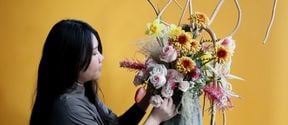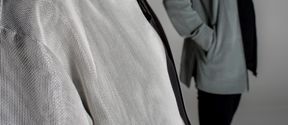Irene Purasachit saw the floral industry’s waste problem firsthand – now she makes material for handbags from discarded blooms
Nearly half of cut flowers end up in the trash, never making their way to dinner tables or first dates

Did you know that the textile, clothing and fashion industry produces yearly 10 % of global carbon dioxide emissions – more than all international flights and shipping combined – and 20 % of global wastewater comes from fabric dyeing and treatment processes? The challenges facing the textile, clothing and fashion industry concern us all.
At the same time, the textile, clothing and fashion industry are one of the drivers of the world economy. The sector employs millions of people and is closely linked to agriculture, chemicals and logistics, among others.
In addition to personal preferences, we are facing big problems.
The desire to break boundaries through cooperation and the courage to question things play a crucial role in the development of innovations throughout a supply chain. For example, how about making clothes from seaweed? Or what if our clothes could serve as energy sources for the future? Imagine a world where creativity, cooperation and courage to innovate turn even wilted flowers into fabric. A sustainable life is possible, but we all need to be part of the solution.
Everyone can buy less and pay attention to the sustainability of clothing and other textiles in their own lives. We can also accelerate system changes by demanding decision-makers and companies to be cleaner, safer and more transparent.

A few years ago, Irene Purasachit, a design student at Aalto University, began to reflect on the sad aftermath of wedding ceremonies in her homeland Thailand with flowers ending up in trash piles. Irene attended a biomaterial course where she developed a method for drying, grinding and mixing petals into pulp. In the next step, the pulp is pressed into a material resembling leather which can, in the future, possibly be used to replace animal leather in various clothing and fashion industry products.
Irene has also planned flower workshops in Thailand where locals learn to combine raw materials, materials manufacturing, design and sales into a whole value chain. In other words, they create new, sustainable jobs for themselves.
Irene Purasachit is currently negotiating with a German boutique shoe manufacturer. Who knows, maybe one day we will wear flower leather shoes!
At Aalto, we see opportunities even there where others only see dead flowers and garbage piles. Would you like to get the latest news on science and art breakthroughs directly to your email?

The world needs new innovations to solve the great sustainability challenges of our time. Aalto carries out multidisciplinary research and development to respond for example to the challenges of the clothing industry. A flourishing future sprouts from the intersection between design and materials science.
Did you know that only about 60 % of Aalto University's expenses are covered by the Ministry of Education's annual budget? The remaining funds are collected from other sources. Donations are used to support the education of the young future experts and to fund experimental innovation and long-term research work. Research and education need your support more than ever.


Nearly half of cut flowers end up in the trash, never making their way to dinner tables or first dates

As the environmental impact of the fashion and textile industries becomes clearer, the demand and need for sustainable alternatives is growing. One international research group aims to replace toxic synthetic dyes with natural alternatives, ranging from plants to microbes to food waste.

A showcase jacket is a tangible result of the Sun-powered Textiles project

“Bioneering” new alternatives

“Care for your clothes like the good friends they are.” - Joan Crawford